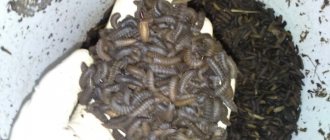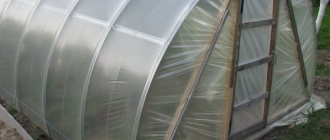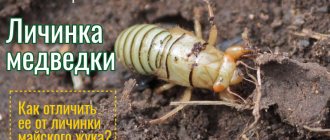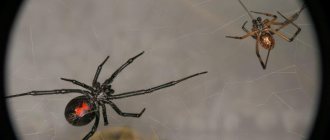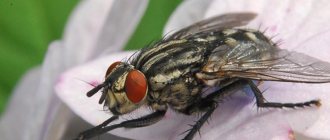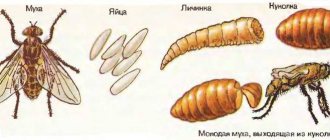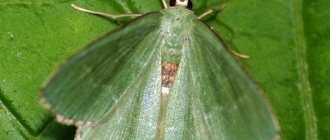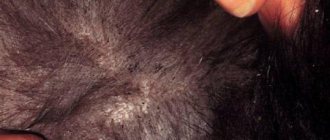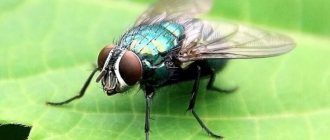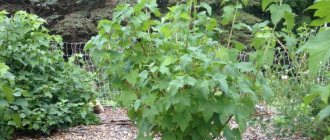Breeding flies
Breeding flies
In laboratory conditions, flight forms of flies are kept in entomological cages-boxes measuring 40 X 40 X 30 cm with walls made of metal mesh or glass. One or two walls, as well as the bottom of the box, are wooden; a hole is made in one of the wooden walls, around which a gauze sleeve is attached; work inside the cage is carried out through this sleeve.
Flies are placed in the cage. Flies are given bread, water, milk and other foods daily as food. For females to lay eggs in the cage, fresh horse manure or bran moistened with water (1:2) is placed on a Petri dish or other appropriate container.
Considering that the development of eggs lasts from 8 to 36 hours, the substrate with laid eggs of flies is removed from the cage daily and transferred to glass containers (wide-necked jars with a capacity of 8-10 liters, curdled milk, crystallizers, etc.).
Food for the larvae can be fresh horse manure (without straw) or bran moistened with water in a ratio of 100 g of bran per 200 g of water. Take 600 g of dry bran and 1200 ml of water into a large jar, add 300 mg of weighed eggs and leave until the flies fly.
If possible, it is recommended to add a small amount of yeast solution to the bran. Adding fresh food is done as follows: the substrate available in the jar is collected by the larvae in one direction, and fresh food is placed on the empty part of the jar; all viable larvae crawl onto this fresh food, after which the old substrate is removed. The humidity of the substrate in which the larvae live should be: for horse manure - 75%, and for bran - on average at least 65-70% (35 g of bran per 65 ml of water).
It is recommended to close jars with larvae with silk sieves. In the absence of such sieves, the vessels with the larvae do not need to be closed, but in this case they should be placed on specially made wooden baking sheets (under the noses). The baking sheet is a sheet of plywood with wooden sides; sand is poured onto it in a layer of 1-2 cm, and the sides are coated with a sticky mass (which is usually used to combat imagoes). At room temperature, the development of larvae takes from 6 to 15 days, and pupae - from 7 to 15 days.
Due to the fact that the third instar larvae look for a drier environment before pupation, they crawl out of the jars into the sand, where they turn into pupae; those of them that will try to crawl away will stick to the sides of the baking sheet; they usually make up a very small percentage.
Covering vessels with larvae with gauze is permissible only for larvae of the first and second instars, since the larvae of the third instar crawl through the gauze, drilling holes in it (as do the adult flies emerging from pupae - see video).
If the flies were hatched in jars, then from the latter they are released into the cages through a gauze sleeve.
In cases where pupae (false cocoons) of flies are selected from sand, the latter is sifted through a sieve.
The selected pupae are counted and placed in cages; This ends the education of one generation of flies.
Mature flies live in the cage for 25-35 days.
You can start breeding flies as follows: put bran moistened with a 20% solution of ammonium carbonate (a non-toxic substance) on a plate; then the plate is placed in a warm room in which there are flies. Female flies in the room, attracted by the smell of ammonium acid charcoal, lay eggs on the bran and after 24-48 hours, first instar larvae hatch from the fly eggs. The entire substrate (bran) with the larvae is transferred to jars. The method for raising larvae is indicated above.
<<< back
Growing technology
Whether you grow larvae for yourself at home or in a large production facility for sale, the technology is the same.
It differs only in the size of the premises, the amount of raw materials and the containers used. Larval production can be divided into several stages:
- Fresh or rotting organic matter is placed in the container. The container itself is placed in a cool, shaded room accessible to the blue blowfly. Other types of flies have smaller larvae.
- After a couple of days, the flies lay eggs in groups on the product.
- The container is closed with a lid with small holes made for air access.
- The larvae begin to grow, and when they reach the desired “marketable” size, they are transferred to sawdust to remove the unpleasant odor.
- After two days, the maggots are transferred again and stored. Keep the larvae at home in the refrigerator. If you miss the moment of moving them to a cold place, the larvae will pupate.
What do house flies look like?
Features of the structure and life of the housefly:
- Color: dark gray, four longitudinal stripes on the top of the chest
- Reproduction: bisexual (male and female)
- Development: approximately 20 days
- What does a fly do in winter: hibernate in all stages. Located in the corners and edges of the room, they can survive cold winters by hibernating.
- How many legs (legs) does a housefly have: 6 legs
- Body shape: small, oval
- Size: Adults are about 4–7.5 mm long.
- Presence of antennae: yes
- Where they are distributed: throughout Russia, found almost everywhere where there is a person. Flies appeared since the Cenozoic era and today, following people, they have colonized the entire planet.
- Lifespan of a housefly: up to 1.5 months
- Houseflies are usually gray in color with four black stripes on the chest.
- Adult houseflies range from 4 to 7.5 mm in length.
- The fly's body is covered with small hairs and has one pair of wings.
- Female house flies are usually larger than males.
- House flies have neither teeth nor stingers.
Advantages and disadvantages
This type of attachment undoubtedly has more pros than cons, and is very popular for good reason. The advantages of the bait include the following:
- maggots are very mobile, actively wriggle on the hook, which attracts fish well;
- they are easy to attach to hooks, they hold very tightly, which allows the use of both float and bottom gear;
- it is one of the main components for preparing various baits for predatory and peaceful fish;
- Maggot is very easy to store.
Despite all the advantages, there are also significant disadvantages. But they are relevant only when purchased, and not when grown at home. These include:
- deficit. Maggot is not sold in all fishing stores, and sometimes it is very difficult to find;
- price. As a rule, prices are greatly inflated, and the larger the larvae, the more money you will have to pay for them.
After weighing the pros and cons, many fishermen decide to grow larvae themselves. All that remains is to find out how to properly breed maggots.
Many fishermen, guided by the desire to increase the attractiveness and catchability of the larvae, show their wildest culinary fantasies, resulting in new types of maggots used in fishing.
We suggest you read: How to get rid of flies in your dacha - read!
The recipe for pickled maggots was invented by English fishermen. The main goal was to ensure that the bait held more firmly on the hook. First, it is marinated in vinegar for an hour, after which it is dried using a regular napkin or additionally baked in the oven. This method can be applied to individuals that may soon deteriorate.
Maggot with egg came to our country from Poland. It’s hard to say whether it performs better or worse in fishing conditions. Before fishing, the maggot should be fed the yolk of a hard-boiled egg. After being eaten, the worm turns yellow. For fans of this method, the question of how to feed maggots for fishing disappears.
Many fishermen are sure that only red maggot can be better than ordinary maggot. It is used by athletes in competitions, who have repeatedly confirmed the effectiveness of such bait. To color the bait, it is dipped in milk with beet juice or food coloring. Plain water with the addition of potassium permanganate, iodine, brilliant green or food coloring is also often used.
When it is not possible to store maggots in the right conditions, some fishermen freeze them and allow them to thaw before going fishing. Based on observations, this option is not very effective, since fish definitely respond better to live bait than to dead bait.
Boiled maggot worm is great for winter and summer fishing. To prepare it, throw it into hot, non-boiling water and take it out after 5-7 minutes.
It is also common to see artificial maggot substitutes. To make it, you need to cut pieces of foam rubber, soak them in egg white and throw them into boiling water. The result is baits that are slightly similar to the original.
A maggot is a fly larva.
Construction of a growing container
How to grow maggots so that they have less contact with unpleasant odors and sticky substrate? Many fishermen easily solved this problem by constructing special maggots that can be used at home. They are easy to make at home with your own hands. And breeding larvae in them does not require frequent human intervention.
The maggot trap consists of three containers placed one on top of the other.
- The upper container is used for storing meat or fish. It has a holey lid and the same bottom.
- The middle container also has a holey bottom; wood shavings or large sawdust are placed in it in a layer of 5-7 centimeters.
- The lower container is used for clean maggots; sawdust is poured into it.
This design works like this:
- We put the meat in the upper container and place it in a shaded place where flies can find the meat.
- After two or three days we check, and if we see that the flies have laid eggs, we cover the top of the structure with a lid and put it in place.
- The hatched maggots grow and, having reached a marketable size, tend to pupate. They fall down and penetrate through the holes into the middle container.
- Having passed through a layer of sawdust or shavings, they are cleaned and fall into the lower vessel, and from there they are removed and packaged in jars that are taken fishing.
The entire production of maggots takes from a week to ten days, depending on the air temperature and the speed at which the blowfly lays its eggs on the prepared substrate.
What does a housefly eat?
The fly's mouthparts are licking and sucking; flies cannot bite or feed on blood.
Flies feed on liquid food in order to eat solid food; flies dissolve the food in saliva in advance.
Flies love sweets: jam, compotes, juices, honey, etc. And larvae need proteins, so they prefer to eat spoiled meat, fish, garbage, and human food.
The fly determines the suitability of food with its taste organs located on its legs.
How many eyes does a housefly have?
Insects for the most part have a pair of compound eyes, which consist of individual small lenses (facets or ommatidia). The house fly has red-brown eyes.
Each facet is a lens, a housefly has 4000 of them in each eye, this allows flies to have “excellent” visual vision, but their visual acuity is a hundred times worse than that of a human, the fly sees normally only at a distance of 40-70 cm, so flies have 3 non-compound eyes. It turns out that the fly has 5 eyes (2 eyes of the main compound eyes and 3 ordinary eyes)
Types of maggots
A maggot worm is a fly larva. The most common types are the following:
- common maggot;
- gozzer;
- pink.
Common maggots are the larvae of meat and cheese flies. It grows up to 15 mm in length, has thick skin and zero buoyancy, and pupates quickly. You can store it in the refrigerator for no longer than three weeks.
Gozzers are the larvae of black and blue flies. They are true giants and grow up to 25 mm in length. They are rightfully considered the best bait for catching large specimens. Pupates even faster than usual - within two weeks. The main disadvantage is that in our country it is very difficult to find and purchase.
We suggest you read: How to get rid of flies in your house and apartment yourself and inexpensively?
Pinka is considered the most popular type. Its parents are steel-colored flies. It grows up to 10 mm, behaves actively on the hook, thanks to which it perfectly attracts fish. There is no need to look for what to feed the maggot for growth, since there will be no more kick.
Although new types of bait appear every year, none of them have yet been able to replicate the success of simple maggots.
Other production methods
Growing maggots at home can be simplified even more, and there are also original ways to breed them.
We suggest you read: When wasps sleep in summer. Where do wasps spend the winter and how do they prepare for winter? Video: Review and macro photography of a dangerous insect of a very aggressive, biting wild wasp sitting in a test tube
This type of maggot can be easily made at home or right on the shore of a pond after fishing. Take a plastic bottle and cut it in half into two parts. Pour a layer of sawdust 5-7 centimeters thick into the lower part. Unscrew the cap and insert the top of the bottle into the bottom, neck down.
In this case, the neck should not reach the sawdust by a couple of centimeters. Next, we put a dead fish, a half-eaten egg, sausage or meat at the top and place the “device for producing larvae” in the shade in a secluded place. When we arrive fishing a week later, we take out the structure and select ready-made larvae.
Above the water
This method of growing is also interesting. On a pond you frequent, choose a tree with a branch overhanging the water. Attach a jar with a holey bottom to this branch. Place a fish or piece of meat in the jar.
Hatching maggots will fall into the water and attract fish to this place. While fishing, all you have to do is throw your tackle with maggots on a hook under a branch and catch fish that are accustomed to feeding on larvae. Make new stockings from time to time, then you will not need to take care of the bait all season.
From eggs
The largest larvae for fishing are obtained from raw or rotten eggs. One fisherman aptly described them as “Michurinsky”. The technology for producing giant maggots is very simple, but it is better not to use it at home because of the very specific “fragrant” smell.
- We take a container and pour a layer of sawdust five to ten centimeters into it, for example, a low old saucepan.
- We place the eggs vertically in the sawdust, strengthen them with sawdust so that they do not fall.
- We break the top of the shell and wait for the flies to arrive.
- Each egg hatches 20-30 larvae, but all of them are “Michurinsky”, some of them can get out of the shell into the sawdust.
Horseflies
Horseflies are a large family of dipterans (there are about 130 species in the USSR), in which the most famous genera are true horseflies (Tabanus), lacewings (Chrysops) and rainflies (Chrysozona, Haematopota). In the dormitory, horseflies are constantly mixed with gadflies, which are a completely different group of insects.
The true horsefly (Tabanus) in its adult state is well known to everyone. Looks like a large, big-eyed fly. The horsefly quietly lands on the unprotected skin of a person who detects its presence, suddenly feeling a sharp pain from the injection. In hot, dry times, horseflies hover in flocks around horses and cows, tormenting them with their stings. In the north, deer suffer from them. They are sometimes carriers of anthrax and tularemia pathogens.
